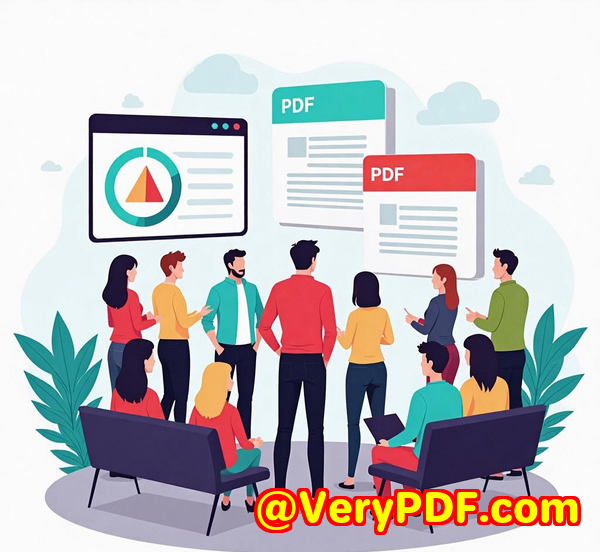Converting Legal Documents to PDFA with VeryDOC SDK Ensuring Long-Term Preservation
Converting Legal Documents to PDF/A with VeryDOC SDK: Ensuring Long-Term Preservation
If you're working with legal documents, you already know how crucial it is to keep them safe and easily accessible for years to come. Whether you're managing contracts, case files, or sensitive legal notes, archiving these files properly is not just a good practice, it's a necessity. Imagine a scenario: you need to retrieve an old legal agreement from a decade ago. You search through countless folders and files, only to find that the document is no longer compatible with newer systems or has lost formatting. Frustrating, right?

That's where VeryDOC PDF to PDF/A Converter Command Line SDK comes in. This powerful tool converts your PDFs into PDF/Athe ISO standard for long-term document preservation. Let's dive into how this SDK can help you streamline your workflow and ensure your important documents stay intact for the long haul.
What is PDF/A?
Before we get into the specifics of the VeryDOC SDK, let's talk about PDF/A. This format is specifically designed for archiving purposes. Unlike regular PDFs, PDF/A files are guaranteed to be self-contained. That means they have all the fonts, images, and formatting information needed to display the document exactly as it was when it was created, regardless of what software or system you're using years down the line.
This is essential for industries like law, where document integrity and preservation are critical. You don't want to worry about files becoming unreadable or misformatted after a few yearsespecially when those documents could be used as evidence in court or as part of an official record.
How Does the VeryDOC PDF to PDF/A Converter SDK Work?
I first came across the VeryDOC PDF to PDF/A Converter SDK when I needed to convert a large batch of legal documents into PDF/A for archiving purposes. The process seemed daunting at first, but with this SDK, I was able to automate the conversion and ensure that the documents met the strict ISO 19005-1 standards. This SDK is designed to be simple to use, yet incredibly powerful.
Here's how it works:
-
Batch Conversion: The tool allows you to convert multiple PDFs at once, saving you hours of manual work. Whether you're working with scanned PDFs or normal ones, it handles both with ease.
-
Embedded Fonts and Content Optimization: It ensures that all fonts are embedded, which is a requirement for PDF/A. Additionally, any device-dependent color spaces are replaced with ICC color profiles, which guarantees color accuracy and compatibility across different systems.
-
Security: The SDK even handles password-protected documents, allowing you to convert encrypted PDFs without issues. This was particularly useful for me when I had to deal with confidential client contracts that were locked with passwords.
-
Prohibited Content Removal: One of the standout features is the removal of prohibited content like JavaScript or interactive forms. This is essential for legal documents, as they need to be clean and simple for long-term preservation. Anything that could cause future compatibility issues is automatically removed during the conversion process.
-
Metadata Inclusion: If your PDF is missing XMP metadata (which includes information like the document's title, author, and keywords), the SDK will add it for you. This ensures that your documents are fully optimized for archiving and future retrieval.
My Experience with VeryDOC SDK
When I started using the VeryDOC PDF to PDF/A Converter, I had a massive archive of legal contracts and case files that needed converting. What impressed me the most was the command-line functionality. As a developer, I'm used to working with scripts, and this SDK made it incredibly easy to integrate PDF/A conversion into my workflow.
The best part? It's completely royalty-free, meaning you don't have to worry about additional costs as your needs scale. With the command-line operations, I could easily set up batch processes to convert large amounts of files automatically. No more manual file conversion, no more worrying about inconsistent formatting. Just clean, standardized PDF/A files ready for the archives.
Here are a couple of scenarios where this tool saved me tons of time and headaches:
-
Legal Case Files: I had a case where the client's documents were in various formatssome were scans, some were digital PDFs. I used the VeryDOC SDK to batch convert everything into PDF/A, ensuring that every file was properly formatted and compliant with archiving standards. The tool automatically handled the font embedding and color optimization, leaving me with pristine, compliant PDFs.
-
Client Contracts: Many of our contracts were password-protected PDFs. Instead of manually unlocking each file to convert it, I simply used the SDK's built-in functionality to handle encrypted PDFs. This saved me hours of work and made the entire process more efficient.
Key Advantages of the VeryDOC PDF to PDF/A Converter SDK
-
ISO 19005-1 Compliance: Ensures your PDFs meet the official PDF/A archiving standards. This is crucial for industries like law, healthcare, and finance, where document preservation is a legal requirement.
-
Supports All PDF Versions: Whether you're dealing with old or new PDFs, this tool can handle it. This is perfect for law firms that have years of accumulated documents to convert.
-
Powerful Command-Line Interface: As a developer, I love that I can integrate this SDK directly into my workflows, automate processes, and streamline large-scale conversions.
-
Wide Platform Support: Whether you're using Windows, macOS, or Linux, the VeryDOC SDK has you covered. It's compatible with all major platforms, which is a must for large law firms with diverse IT ecosystems.
-
Security: The ability to handle encrypted PDFs directly is a game-changer. I didn't have to manually unlock each document before converting itsaving both time and frustration.
-
Cost-Effective: Unlike other PDF/A conversion tools, the VeryDOC SDK offers a royalty-free license, making it a cost-effective solution for businesses that need to convert a high volume of documents regularly.
Real-World Use Cases for Legal Teams
Here are a few real-world scenarios where this tool can be a lifesaver:
-
Archiving Contracts: Legal teams can use this SDK to convert contract files into PDF/A for long-term storage. This ensures that contracts remain readable and accessible even after years of archiving.
-
Compliance with Legal Archiving Regulations: Many industries require that documents be kept for a certain period, and in a specific format, for legal compliance. Using PDF/A ensures that documents remain compliant with these regulations.
-
Court Evidence Preservation: Court cases can go on for years. With the PDF/A format, legal teams can preserve documents that might be needed as evidence in the future, ensuring they are not altered and remain as they were at the time of submission.
Why I Recommend This SDK
If you're dealing with large volumes of PDFs and need to convert them into a format that guarantees long-term preservation, the VeryDOC PDF to PDF/A Converter SDK is exactly what you need.
It's fast, efficient, and easy to use. I'd highly recommend it to anyone working in the legal, financial, or government sectors, where document preservation is not just a preference but a requirement. With this SDK, you can rest assured that your documents will be compliant, secure, and easily accessible for years to come.
Start your free trial now and boost your document management process: https://www.verydoc.com/pdf-to-pdfa.html
FAQ
Q1: Can I use the VeryDOC SDK to convert password-protected PDFs?
Yes, the SDK supports converting password-protected PDFs directly, saving you time and effort.
Q2: Is the VeryDOC SDK compatible with all versions of PDF?
Absolutely! It works with all PDF versions, so whether you're dealing with old or new files, it's covered.
Q3: Can I automate PDF to PDF/A conversion using scripts?
Yes, the SDK's command-line interface makes it easy to integrate into automated workflows for batch processing.
Q4: What is the benefit of using PDF/A for archiving?
PDF/A ensures that your documents are self-contained and will remain readable and properly formatted for years to comecritical for long-term archiving.
Q5: Does the SDK support both normal and scanned PDFs?
Yes, it supports both, ensuring that all types of PDFs are properly converted into PDF/A.
Keywords: PDF to PDF/A, legal document preservation, PDF/A SDK, PDF conversion tool, archive PDF, PDF to PDF/A converter, automated PDF conversion, command-line PDF converter, encrypted PDF conversion



